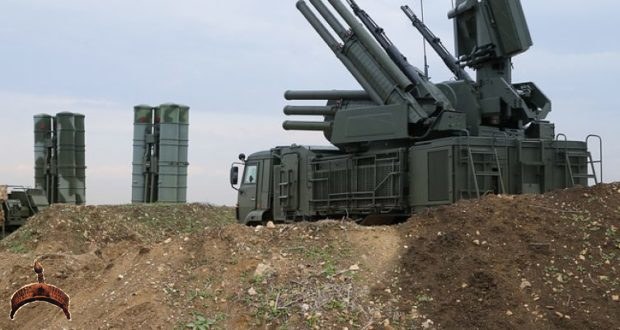Russians are typically good at some things, and not so good at others. One of the things which Russian politicians are still terrible at, is avoiding self-inflicted PR disasters. Remember how Russian officials mismanaged the entire topic of “S-300s for Syria” (if not, then check out “part six” of this analysis)? Something similar is happening again, but this time with the procurement of new advanced and expensive weapons systems.
We have all seen the “Russia is canceling the Su-57!” and “Russia cannot afford the new Armata T-14 tank!” headlines. Pretty soon I expect to see something along the lines of “US sanctions force Putin to abandon the XXXX” (fill the blank with whatever weapon system you want). So is there any truth to any of that?
Well, yes and no.
Aircraft and main battle tanks
What is true is that Russian officials have been way too eager to declare that the Russian military will soon have many weapons systems much superior to anything produced in the West. Alas, these same officials rarely bothered explaining where, why, when and how many of these weapons systems actually would be deployed. That kind of ambiguous message makes it look like Russia is zig-zagging (again!). Perfect example: Russia deploys 4 Su-57s to Syria and then appears to more or less cancel or, at least, dramatically reduce the procurement of this weapons system. The reality is both much simpler and a little more complex. And to explain what is taking place we need to first understand the difference in military procurement in the West and in Russia.
In the West, the main goal of any procurement of any weapons system is the transfer of as much money as possible from the government to the pockets of the private individuals controlling the Military-Industrial Complex. Put differently, Western force planning (especially in the US) is not threat or mission-driven, but profit driven. And while some outrageously expensive weapons systems do get canceled (like the Boeing–Sikorsky RAH-66 Comanche attack helicopter), other even more expensive and poorly designed ones remain funded (such as the F-35). This is the kind of situation only a fantastically corrupt country with no real threat to itself can afford. In contrast, Russia is far less corrupt and has potential enemies right across most of her borders.
In contrast, Russian force planning is threat/mission driven. This means that before the Russian military decides that it needs X number of Su-57 or T-14s it has to make the case that there is a threat which only Su-57s and T-14s can counter (or, at least, that it makes more sense – human, economic or tactical – to use new systems)
During the Cold War, the general rule (there were exceptions, of course!) was that the US was typically the first side to deploy a new technology/capability which the Soviets then studied before developing a counter-capability once the strengths and weaknesses of the new US technologies/capabilities were fully understood. The price to pay for that method was that the Soviets were usually one step behind the US in deploying a new technology. The main advantage of this dynamic for the Soviets was that their weapons systems typically ended up being both cheaper and superior. A good example of this kind of dynamic is the development of the Su-27 in response to the US development of the F-15 or the development of the Akula-class SSN in response to the Los Angeles-class SSN by the USN.
Today the situation is quite different. If you compare Russian and western weapons systems (say, the latest versions of the Su-35/Su-30s vs the latest versions of the F-15s/16s/18s or the T-90/T-72B3/B3M vs the Abrams/Leopard MBTs) you realize that the current Russians systems are at least as good as their US/EU counterparts, if not better. This happened because with the official end of the Cold War US/EU force planners decided to waste money on hugely expensive weapons systems instead of modernizing their aging aircraft or tanks. After all, 20-30-year-old tanks and aircraft were more than adequate to deal with such “threats” as Iraq or Yugoslavia, so why waste the money: nobody expected Russia to be able to rebound as fast as she did.
All this begs the question of what threats the Su-57s or T-14s were supposed to deal with? Logically this threat would have to be a threat which already existing Su-35s or modernized T-72/80/90s could not deal with. Can such threats be identified? Probably yes, both in the West and, in the case of aircraft, in the East. But how big (in terms of numbers) this threat will actually be is a huge question. For example, I would argue that the only strategic direction in which the deployment of T-14 would make sense is the West, specifically for the First Guards Tank Army which would have to fight NATO in case of a war. And even in this case, there is an optimal mix of old/new MBTs inside the two divisions composing the backbone of this Army which would make more sense than replacing all their current MBTs with T-14s (this will be especially true if a 152mm gun version of the Armata is ever deployed). As for deploying the T-14s to the South or East of Russia, it would make no sense at all since no opposing force in these directions would have armor superior to the Russians. In the case of air-power, this issue is not so much a geographical one (tactical air-power can be rapidly moved from one location to another one) as it is the number of F-22s/F-35s/(X-2s?) the US and its allies could deploy against Russia (assuming air-to-air refueling and that the F-35 actually works as advertised).
[Sidebar: in reality only comparing tactical aircraft to tactical aircraft and MBTs to other MBTs is a gross oversimplification; in the real world you would have to compare the full spectrum of capabilities of both sides, such as MBTs vs anti-tank weapons or attack helicopters (in the case or air combat this would be even much more complicated), so I kept it simple just for illustration purposes.]
For the foreseeable future, the threat to Russia will come from the latest iterations of the F-16/15/18s in which case the Su-35s/Su-30SM/Mig-25SMT/MiG-35/MiG31BM will be more than enough to deal with that threat, especially with their new radar+missile combos. And for a more advanced threat, a combination of Su-57s and already existing generation 4++ aircraft makes more sense than trying to deploy thousands of 5th generation aircraft (which is what the US is currently doing).
Finally, there is the issue of exports. While exports can help finance the costs of new and very pricey systems, the export potential of already existing Russian systems is much bigger than the one of recently deployed systems. Originally, the Russians had hoped to basically co-develop the Su-57 with India, but the pressures of the very powerful pro-US lobby inside India combined with differences in design philosophy and technical requirements have made the future of this collaboration rather uncertain. Of course, there is China, but the Chinese also have to ask themselves the question of how many Su-57 they would really want to purchase from Russia, especially considering that they have already purchased many Su-35s and are still working on their own 5th generation aircraft.
The Cold War years illustrate how the Soviet Union dealt with this problem: both the advanced and expensive Su-27 and the cheaper, but still very effective, MiG-29 were developed and deployed more or less simultaneously (along with some very good missiles) and while the Sukhoi was a much more complex aircraft with a much bigger upgrade potential, the MiG was cheap, fantastically maneuverable and superbly adapted to it’s “front line fighter” mission in spite of not even having fly-by-wire! It is therefore hardly surprising that Russian force planners today would like similar options.
Which makes me wonder which major weapon procurement program will be “mothballed” next?
Russian aircraft carriers and aircraft-carrying assault ships
My vote goes for the much announced Russian Project 23000 “Storm” super aircraft carrier (check out this article by Andrei Martyanov on this topic). Without going into the issue of whether Russia needs aircraft carriers and, if yes, what kind exactly (I personally think that the Russian Navy has more important programs to spend money on), it strikes me as extremely premature to declare, in 2018, that Russia plans to deploy not one, but three or even four (!), such super aircraft carriers. The reality is that for the foreseeable future budgetary and technological constraints will only allow Russia to build one carrier and that that carrier will probably be what Martyanov calls a “niche” carrier. Oh sure, if the Russian military budget was anywhere near the US one and if the Russian MIC was anywhere near as corrupt as the one of the United States, three or four carriers would be possible, but as long as every ruble has to be accounted for and justified through a comparison of opportunity costs and mission requirements, this will not happen. I am still waiting to see if the Russian Navy will ever get the promised “Priboi” universal assault ships to replace the French “Mistrals” and, if that happens, what the Priboi-class will actually look like, how they will be equipped and when they will be accepted for operation by the Russian Navy.
Conclusion: less hype, more common sense please!
Russia has, and will developed, new, expensive and advanced weapons systems simply because she needs to maintain the technological and industrial capabilities to keep up with the evolving threats. You cannot build a 6th generation fighter if you have not ever developed a 5th-generation one. However, Russia has had to tackle the immensely complicated task of replacing all the systems components previously developed abroad (say, in the Ukraine) with indigenous ones. Following western sanctions, it has become absolutely self-evident that Russian weapons systems must be built exclusively with Russian technologies and components (which, by the way, their US counterparts are not). While Russia did benefit from the brain-drain from the Ukraine (and other ex-Soviet republics) which saw many highly skilled engineers and scientists leave following the collapse of the Ukrainian industrial base, Russian resources have still been severely stretched by the urgent need to create a truly autonomous military-industrial complex, most of it ex nihilo. Furthermore, there are still technological and industrial bottlenecks which need to be dealt with before Russian can produce her new weapon systems in sufficient numbers (that is especially true of large warships). As of today, the goal of full “import substitution” has not been fully realized, even if immense progress towards it has already been made.
The one thing Russia could – and should – immediately do is learn how to present a consistent and balanced message to her public opinion. Every time loud and triumphant declarations are followed by more sober assessments, the anti-Putin forces in Russia (and abroad) scream to high heavens about “Putin” having promised the sky and delivered nothing (again, the entire mess with S-300s for Syria is a perfect example of this). So yes, Russia public relations still often suck. But there is nothing wrong with Russian force planning.
The Saker
 Ọmọ Oòduà Naija Gist | News From Nigeria | Entertainment gist Nigeria|Networking|News.. Visit for Nigeria breaking news , Nigerian Movies , Naija music , Jobs In Nigeria , Naija News , Nollywood, Gist and more
Ọmọ Oòduà Naija Gist | News From Nigeria | Entertainment gist Nigeria|Networking|News.. Visit for Nigeria breaking news , Nigerian Movies , Naija music , Jobs In Nigeria , Naija News , Nollywood, Gist and more








